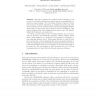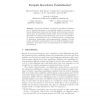225 search results - page 26 / 45 » From sequential programs to concurrent threads |
CP
2010
Springer
13 years 5 months ago
2010
Springer
We introduce a parallelized version of tree-decomposition based dynamic programming for solving difficult weighted CSP instances on many cores. A tree decomposition organizes cost ...
KBSE
2009
IEEE
14 years 2 months ago
2009
IEEE
Abstract—Many applications are concurrent and communicate over a network. The non-determinism in the thread and communication schedules makes it desirable to model check such sys...
VMCAI
2009
Springer
14 years 2 months ago
2009
Springer
This paper describes the methods used in Empire, a tool to detect concurrency-related bugs, namely atomic-set serializability violations in Java programs. The correctness criterion...
LCPC
2009
Springer
14 years 6 days ago
2009
Springer
Abstract. We describe Fastpath, a system for speculative parallelization of sequential programs on conventional multicore processors. Our system distinguishes between the lead thre...
ACMMSP
2006
ACM
14 years 1 months ago
2006
ACM
Many people have proposed adding transactions, or atomic blocks, to type-safe high-level programming languages. However, researchers have not considered the semantics of transacti...


